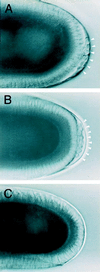Essential role of mitochondrially encoded large rRNA for germ-line formation in Drosophila embryos
- PMID: 9736726
- PMCID: PMC21632
- DOI: 10.1073/pnas.95.19.11274
Essential role of mitochondrially encoded large rRNA for germ-line formation in Drosophila embryos
Abstract
In Drosophila, pole cells, the progenitors of the germ line, are induced by the factors localized in the posterior pole region of oocytes and cleavage embryos, or germ plasm. Polar granules in germ plasm are electron-dense structures and have been proposed to contain factors essential for pole cell formation. Mitochondrially encoded large ribosomal RNA (mtlrRNA) has been identified as a component of polar granules. We previously have shown that mtlrRNA is able to rescue embryos that fail to form pole cells as a result of UV irradiation. However, there is a possibility that the function of mtlrRNA is limited to UV-irradiated embryos, and the question of whether mtlrRNA is required for the normal pathway leading to pole cell formation remains unanswered. In this study, we report that the reduction of mtlrRNA in germ plasm by injecting anti-mtlrRNA ribozymes into cleavage embryos leads to their inability to form pole cells. Other components of germ plasm, namely oskar mRNA, germ cell-less mRNA, and Vasa and Tudor proteins appear to be unaffected in these ribozyme-injected embryos. These results support an essential role for mtlrRNA in pole cell formation. We propose that mitochondrially encoded molecules participate in a key event in early cell-type specification.
Figures


References
Publication types
MeSH terms
Substances
LinkOut - more resources
Full Text Sources
Other Literature Sources
Molecular Biology Databases

